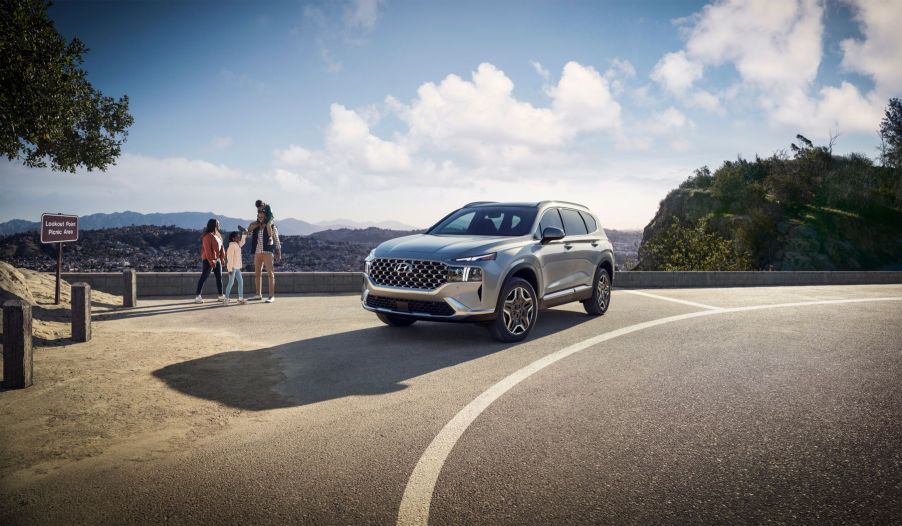
3 Advantages the 2023 Hyundai Santa Fe PHEV Has Over the Kia Sportage PHEV
Plug-in hybrids don’t always get the same love as hybrids, and most people tend to confuse the two. In fact, plug-in hybrid electric vehicles (PHEVs) are often an overlooked corner of the automotive market, and many view them as a transitional point between standard hybrids and fully electric vehicles.
There are several PHEVs in the market, but in this article, we will explore two PHEV SUVs and compare their advantages to find out which is the best PHEV SUV in the market. Here are three advantages the 2023 Hyundai Santa Fe PHEV has over the Kia Sportage PHEV.
1. The Hyundai Santa Fe Plug-in Hybrid has a bigger fuel tank
Some vehicles are built for adventure, and the 2023 Hyundai Santa Fe PHEV is one of those cars. If you’re looking for a vehicle that will allow you to carry more fuel, then you may need to forego the 2023 Kia Sportage PHEV for the Hyundai Santa Fe PHEV, which has more fuel tank capacity.
The Hyundai Santa Fe PHEV has a gas tank size of 12.4 gallons and offers 30 miles of electric range, meaning it can stay on the road longer than the Kia Sportage PHEV, which has a gas tank size of 11.1 gallons. However, the Kia Sportage PHEV offers 34 miles of electric range, which is more than the Hyundai Santa Fe PHEV.
2. The Santa Fe PHEV has more towing and payload capacity

When properly equipped, you can trust the 2023 Hyundai Santa Fe PHEV’s payload capacity of 1,455 lbs. over Kia Sportage PHEV’s 1,124 lbs. According to Edmunds, the Santa Fe PHEV’s curb weight is 4,387 lbs., while its gross weight is 5,842 lbs. Meanwhile, the Kia Sportage has a gross weight of 5,335 lbs. and a curb weight of 4,211 lbs.
When fully loaded, the Kia Sportage PHEV can tow up to 2,500 lbs., but the Santa Fe edges it out significantly. The Santa Fe is an excellent SUV for towing, as its maximum towing capacity is 3,500 lbs.
3. The Hyundai Santa Fe PHEV has more cargo capacity than the Kia Sportage PHEV
The Kia Sportage PHEV provides 34.5 cubic feet of cargo space behind the rear seat and 65.5 cubic feet with the rear seats folded down. In comparison, the Hyundai Santa Fe offers more space than its rivals, with 36.4 cu. ft. of cargo volume behind the second row of seating and 72.1 cu. ft. behind the front seats.
What’s good about each plug-in hybrid electric vehicle (PHEV)?
The Kia Sportage has a 1.6-liter four-cylinder turbo engine, an electric motor, and a 13.8-kWh battery pack which all combine to create 261 hp and 258 lb-ft of torque. The vehicle can rev up from 0 to 60 mph in 7.2 seconds which is impressive but not as impressive as the 6.6 seconds Hyundai Santa Fe takes to reach 60 mph from 0. Additionally, the Santa Fe PHEV has a 13.8-kWh battery pack that puts out 260 hp and 258 lb-ft of torque.
The 2023 Kia Sportage Plug-in Hybrid has two trims the X-Line, which goes for $38,490, and the X-Line Prestige, which has an MSRP of $42,990. The 2023 Hyundai Santa Fe Plug-in Hybrid has two trims, the SEL Convenience and the Limited trim. The SEL Convenience trim has an MSRP of $40,000, while the Limited starts at $46,010.
Ultimately, if you’re conscious of the price tag and want to save some coins, the Kia will do that for you, but for more space and capabilities, the Hyundai is your best shot.


